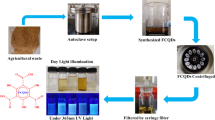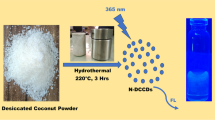Abstract
A dual-mode electrochemical biosensor for acetamiprid detection was proposed for the first time based on carbon quantum dots/Prussian blue (CQDs/PB)-functionalized poly(3,4-ethylenedioxythiphene) (PEDOT) nanocomposite. The nanocomposite with spherical stacking nanostructure showed high surface area, excellent catalytic ability, and cycling stability. The biosensor can be effortlessly constructed after the immobilization of acetamiprid aptamer. The concentration of acetamiprid can be determined by differential pulse voltammetry (DPV) based on its signal change deduced from the pristine PB. With the capture of acetamiprid, the response current (I-T) signal generated by hydrogen peroxide catalysis from the biosensor can also been used to establish the method for monitoring acetamiprid. The dual-mode biosensor showed a wide linear range from 10−12 g mL−1 to 10−6 g mL−1, low detection limits of 6.84 × 10−13 g mL−1 and 4.99 × 10−13 g mL−1, and ultrafast detection time of 25 s and 5 s through DPV and I-T mode, respectively. The biosensor possessed excellent selectivity and stability. More importantly, the biosensor was successfully applied to detect acetamiprid residues in vegetables, proving a promising approach for routine detection of pesticide in real samples.
Graphical abstract
The biosensor based on PEDOT/CQDs/PB for acetamiprid can be effortlessly constructed through both the increase of differential pulse voltammetry (DPV) signal change deduced by the pristine PB and the decrease of the response current (I-T) signal of the reduction of hydrogen peroxide catalyzed by PEDOT/CQDs/PB.







Similar content being viewed by others
References
Li H, Qiao Y, Li J, Fang H, Fan D, Wang W (2016) A sensitive and label-free photoelectrochemical aptasensor using Co-doped ZnO diluted magnetic semiconductor nanoparticles. Biosens Bioelectron 77(77):378–384
Balsebre A, Baez ME, Martinez J, Fuentes E (2018) Matrix solid-phase dispersion associated to gas chromatography for the assessment in honey bee of a group of pesticides of concern in the apicultural field. J Chromatogr A 1567:47–54
Hirotaka O, Msahiro O, Kazuhiko A, Yoko K, Shinjiro H (2002) Determination of acetamiprid, imidacloprid, and nitenpyram residues in vegetables and fruits by high-performance liquid chromatography with diode-array detection. J Agr Food Chem 50(16):4464–4467
Faraji M, Noorbakhsh R, Shafieyan H, Ramezani M (2018) Determination of acetamiprid, imidacloprid, and spirotetramat and their relevant metabolites in pistachio using modified QuEChERS combined with liquid chromatography-tandem mass spectrometry. Food Chem 240:634–641
Bera MK, Behera L, Mohapatra S (2021) A fluorescence turn-down-up detection of Cu2+ and pesticide quinalphos using carbon quantum dot integrated UiO-66-NH2. Colloids Surf A 624(2021):126792
Vasilescu A, Marty J (2016) Electrochemical aptasensors for the assessment of food quality and safety. TrAC Trends Anal Chem 11(024):60–70
Kong X, Zhang B, Wang J (2021) Multiple roles of mesoporous silica in safe pesticide application by nanotechnology: a review. J Agric Food Chem 69(2021):6735–6754
Lu H, Wang H, Yang L, Zhou Y, Xu L, Hui N, Wang D (2021) A sensitive electrochemical sensor based on metal cobalt wrapped conducting polymer polypyrrole nanocone arrays for the assay of nitrite. Microchim Acta 189(1):26
Hui N, Wang J, Wang D, Wang P, Luo X, Lv S (2022) An ultrasensitive biosensor for prostate specific antigen detection in complex serum based on functional signal amplifier and designed peptides with both antifouling and recognizing capabilities. Biosens Bioelectron 200:113921
Li Y, Li Y, Hong M, Bin Q, Lin Z, Lin Z, Cai Z, Chen G (2013) Highly sensitive protein molecularly imprinted electro-chemical sensor based on gold microdendrites electrode and prussian blue mediatedamplification. Biosens Bioelectron 42C(Complete):612–617
Carneiro S V, Queiroz V R, Cr Uz A, Fechine L, Fechine P (2019) Sensing strategy based on carbon quantum dots obtained from riboflavin for the identification of pesticides. Sens Actuators B 301(August):127149
Jiang Y, Zhang X, Shan C, Hua S, Zhang Q, Bai X, Dan L, Niu L (2011) Functionalization of graphene with electrodeposited Prussian blue towards amperometric sensing application. Talanta 85(1):76–81
Yang L, Wang J, Lü H, Hui N (2021) Electrochemical sensor based on Prussian blue/multi-walled carbon nanotubes functionalized polypyrrole nanowire arrays for hydrogen peroxide and microRNA detection. Microchim Acta 188(1):1–12
Wang L, Tricard S, Yue P, Zhao J, Fang J (2016) Polypyrrole and graphene quantum dots @ Prussian Blue hybrid film on graphite felt electrodes: application for amperometric determination of l-cysteine. Biosens Bioelectron 77(2016):1112–1118
Su A, No A, Ma B (2021) Enzyme-free detection of hydrogen peroxide with a hybrid transducing system based on sodium carboxymethyl cellulose, poly(3,4-ethylenedioxythiophene) and Prussian blue nanoparticles. Anal Chim Acta 1172(2021):338664
Jin E, Lu X, Cui L, Chao D, Wang C (2010) Fabrication of graphene/prussian blue composite nanosheets and their electrocatalytic reduction of H2O2. Electrochim Acta 55(24):7230–7234
Wang L, Ye Y, Lu X, Wu Y, Sun L, Tan H, Xu F, Song Y (2013) Prussian blue nanocubes on nitrobenzene-functionalized reduced graphene oxide and its application for H2O2 biosensing. Electrochim Acta 114(2013):223–232
Wang C, Li Z, Guo Z, Xu J, Wang H, Zhai K, Xin Z (2010) A novel hydrazine electrochemical sensor based on the high specific surface area graphene. Microchim Acta 169(1–2):1–6
Xu E, Yang H, Li P, Wang Z, Liu S (2020) Dual-mode detection of PARP-1 by fluorescence and chemiluminescence. Sens Actuators B 330(20):129288
Guo CX, Zhao D, Zhao Q, Peng W, Lu X (2014) Na+-functionalized carbon quantum dots: a new draw solute in forward osmosis for seawater desalination. Chem Commun 50(55):7318–7321
Hui N, Wang W, Xu G, Luo X (2015) Graphene oxide doped poly(3,4-ethylenedioxythiophene) modified with copper nanoparticles for high performance nonenzymatic sensing of glucose. J Mater Chem B 3(4):556–561
Wang J, Wang D, Hui N (2020) A low fouling electrochemical biosensor based on the zwitterionic polypeptide doped conducting polymer PEDOT for breast cancer marker BRCA1 detection. Bioelectrochemistry 136:107595
Cao L, Liu Y, Zhang B, Lu L (2010) In situ controllable growth of Prussian blue nanocubes on reduced graphene oxide: facile synthesis and their application as enhanced nanoelectrocatalyst for H2O2 reduction. ACS Appl Mater Interfaces 2(8):2339–2346
Martindale B, Hutton G, Caputo CA, Reisner E (2015) Solar hydrogen production using carbon quantum dots and a molecular nickel catalyst. J Am Chem Soc 137(18):6018–6025
He Y, Zhou X, Zhang X, Ma L, Jiang Y, Gao J (2020) Self-reducing Prussian blue onTi3C2Tx MXene nanosheets as a dual-functional nanohybrid for hydrogen peroxide and pesticide sensing. Ind Eng Chem Res 59(35):15556–15564
Madrakian T, Maleki S, Gilak S, Afkhami A (2017) Turn-off fluorescence of amino-functionalized carbon quantum dots as effective fluorescent probes for determination of isotretinoin. Sens Actuators B 247(03):428–435
Ozeki T, Watanbe I, Ikeda S (1987) Study of the prussian blue/prussian white redox reaction by cyclic voltammothermometry. J Electroanal Chem 236(1–2):209–218
Oghli A, Soleymanpour A (2021) Pencil graphite electrode modified with nitrogen-doped graphene and molecular imprinted polyacrylamide/sol-gel as an ultrasensitive electrochemical sensor for the determination of fexofenadine in biological media. Biochem Eng J 167:107920
Xue Q, Fang X, Dong T, Pei C, Jian L, Jin G (2019) Ultrasensitive “signal-on” electrochemical aptasensor for assay of acetamiprid residues based on copper-centered metal-organic frameworks. Anal Chim Acta 1050(2018):51–59
Rapini R, Cincinelli A, Marrazza G (2016) Acetamiprid multidetection by disposable electrochemical DNA aptasensor. Talanta 161:15–21
Xiao S, Jian S, Yao Y, Hui L, Jing H, Ye G (2020) Novel electrochemical aptasensor with dual signal amplification strategy for detection of acetamiprid. Sci Total Environ 705:135905
Ye G, Feng Y, Yao Y, Jian L, Shu C, Hao D (2021) Novel Au-tetrahedral aptamer nanostructure for the electrochemiluminescence detection of acetamiprid. J Hazard Mater 401:123794
Na S, Yuan D, Zhe T, Hongjie Y, Xiu H, Ming W (2018) Development of an upconversion fluorescence DNA probe for the detection of acetamiprid by magnetic nanoparticles separation. Food Chem 258:289–294
Qian L, Juan H, Xiao D, Jing Q, Nan H, Tian Y, Han M, Kun W (2016) Resonance energy transfer from CdTe quantum dots to gold nanorods using MWCNTs/rGO nanoribbons as efficient signal amplifier for fabricating visible-light-driven “on-off-on” photoelectrochemical acetamiprid aptasensor. Sens Actuators, B 235:647–654
Hassan OA, Soleymanpour, (2021) Pencil graphite electrode modified with nitrogen-doped graphene and molecular imprinted polyacrylamide/sol-gel as an ultrasensitive electrochemical sensor for the determination of fexofenadine in biological media. Biochem Eng J 167:107920
Rouhani M, Soleymanpour, (2020) Preparation of Dawson heteropolyacid-embedded silver nanoparticles/graphene oxide nanocomposite thin film used to modify pencil graphite electrode as a sensor for trace electrochemical sensing of levodopa. Mater Sci Eng C 117:111287
Tang X, Li X, Ma D, Lu L, Qu B (2018) A label-free triplex-to-G-qadruplex molecular switch for sensitive fluorescent detection of acetamiprid. Talanta 025(18):30717–30713
Funding
This work was funded by the National Natural Science Foundation of China (21705088), Shandong Provincial Key R&D Plan (Major Scientific and Technological Innovation Project) (2022CXGC010611, 2022CXGC010401), and Shandong Provincial Peanut Industry Technology System Project (SDAIT-04–09).
Author information
Authors and Affiliations
Corresponding author
Ethics declarations
Conflict of interest
The authors declare no competing interests.
Additional information
Publisher's note
Springer Nature remains neutral with regard to jurisdictional claims in published maps and institutional affiliations.
Supplementary Information
Below is the link to the electronic supplementary material.
Rights and permissions
Springer Nature or its licensor holds exclusive rights to this article under a publishing agreement with the author(s) or other rightsholder(s); author self-archiving of the accepted manuscript version of this article is solely governed by the terms of such publishing agreement and applicable law.
About this article
Cite this article
Shang, S., Wang, D. & Wang, J. Electrochemical determination of acetamiprid using PEDOT sensing coating functionalized with carbon quantum dots and Prussian blue nanoparticles. Microchim Acta 189, 341 (2022). https://doi.org/10.1007/s00604-022-05434-y
Received:
Accepted:
Published:
DOI: https://doi.org/10.1007/s00604-022-05434-y




